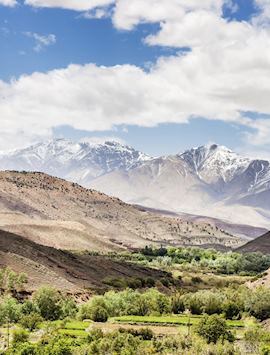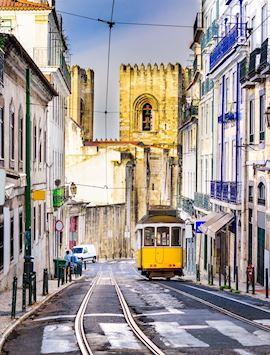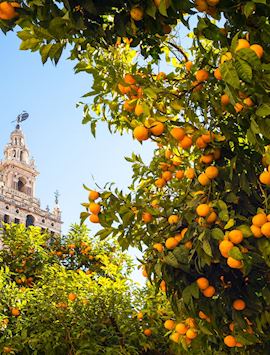A blend of Indigenous Amazigh culture, Islamic spirituality, and European influence slowly reveals itself as you move through Morocco. A single tour can combine its cities, mountains, desert, and coast, or you can hone in on the landscapes and cultures that speak to you most, from Marrakesh’s labyrinthine souqs to the wind-sculpted sands of the Erg Chebbi. You could even include time in Spain or Portugal, where Morocco’s story further unfolds.
Whatever route you choose to take, we can help you untangle Morocco’s complex past and get you closer to its authentic culture. You might spend the day with a local family in the High Atlas Mountains, learn the secrets behind a perfectly spiced tagine on a food tour of Marrakesh, or try birdwatching in a national park far away from the chaos of the cities.
To help you plan your trip to Morocco, we’ve brought together our specialists’ tried and tested Morocco tour ideas below.
Pick your trip
1. Marrakesh, the High Atlas Mountains & more

From twisting souqs that spill over with spices to the still of the mountains, this tour idea gets to the heart of Morocco’s culture, both traditional and modern. It balances adventure and relaxation in equal measure, and (save for a trip to the coast), everything is within a one-hour drive.
Where the trip could take you:
Flying into Marrakesh, you’ll spend a couple of days exploring the city’s storied history before your private driver takes you an hour south to the stark landscapes of the High Atlas Mountains. You could also visit the fortified coastal town of Essaouira or the Agafay desert during this trip — both showcase another facet of Moroccan culture and history.
Experiences you can have:
Culture takes pride of place in Marrakesh, and a local guide is the best person to help you peel back its many layers. You might choose to venture into the city’s maze-like souqs to learn the art of haggling, or perhaps you’d prefer to focus on historic landmarks, like Koutoubia Mosque and the Saadian Tombs, as your guide shines a light on local spirituality and traditions.
If you’d like to explore the city through your tastebuds, we can also arrange a private culinary walking tour, where you can sample local delicacies like succulent grilled meats, spiced tagines, and freshly squeezed orange juice.
In the mountains, we recommend spending the day with an Amazigh family, where you’ll learn how to make a fragrant tagine. You can also watch how local artisans expertly weave dwarf palm into baskets and other handicrafts as your host shows you around their village.
2. Into the desert: Erg Chebbi

A vast sea of burnt-ochre dunes shimmers under the relentless sun in Erg Chebbi. If you’re looking for a classic desert experience as you plan your trip to Morocco, this is it. It’s one of the most accessible dune-filled locations in the country but still several hours’ drive from Marrakesh and Casablanca, so we suggest making a handful of scenic stops along the way.
Where the trip could take you:
Spend a couple of days in Marrakesh before embarking on your journey to the desert. With a private driver at the wheel, you’ll first cut through the High Atlas Mountains toward the oasis town of Skoura. After a night here, it’s another few hours’ drive to Erg Chebbi for your desert stay. On the way back, we suggest breaking up the journey with time in the desert outpost of Zagora before looping back to Marrakesh. Alternatively, head further north to Fez, another of Morocco’s imperial cities, before ending in Casablanca.
Experiences you can have:
Private walking tours of the medina, souqs, and historical landmarks of Marrakesh are one way to experience the city. But, if you want a taste of the desert before you head to Erg Chebbi, you might enjoy a quad-biking tour that takes you into the surrounding sun-scorched land and nearby palm oasis.
However, it’s just that — a taste. Compared to the thin layer of sandy dirt that veils the desert near Marrakesh, Erg Chebbi appears to be a sea of sand, with dunes stretching out for miles into the horizon. To best appreciate it after your long journey, we suggest a camel ride at sunset, when the light casts huge shadows across the dunes and paints them in a new shade of orange each minute.
As for the rest of your time in the desert, you can choose to relax or take a more adventurous approach. Your desert camp will offer a range of guided and self-guided experiences, from stargazing to sand boarding, as well as gentle walks to visit nearby nomad settlements.
3. Exploring Southern Morocco

The south of Morocco often flies under the radar, leaving its arid desert plateaux, verdant palm oases, and quiet coastlines unspoiled by tourism. Away from the crowds, you can experience local life at its most authentic as you visit ochre-hued villages and fortified towns before relaxing beside the ocean. It’s particularly good if you’re planning a second-time trip to Morocco, having seen the main highlights.
Where the trip could take you:
After spending a few days in Marrakesh and the High Atlas Mountains, your driver will take you south to stay in the walled city of Taroudant. Then, you’ll travel further down the country to Tafraoute, an Amazigh town circled by red-rock peaks. We suggest staying here a night, before spending a few days on the coast within Souss-Massa National Park, an hour’s drive from the airport in Agadir.
Experiences you can have:
In Morocco’s lesser-visited south, there are kasbahs (fortresses) everywhere — thousands of them, in fact. Constructed using natural materials that blend with the sun-baked surroundings, it often looks as if they’ve erupted from the earth itself. You’ll see many as you journey down the country with your driver-guide, who can tell you more about their history and significance as you go.
On this trip, there’s plenty of time to explore on your own, wandering through palm-shaded medinas and souqs bursting with Amazigh handicrafts. In Tafraoute, we also suggest visiting the painted rocks. Here, bright bursts of colour pop against the barren, boulder-strewn landscape, the curious work of European artist Jean Verame.
Wildlife isn’t a focal point in many Morocco trips, but in Souss-Massa National Park, birdwatching opportunities are plentiful. Paired with an expert guide, you’ll walk through the park, along its riverbanks and desert plateau, to search for an array of species, including black-crowned tchagras, purple herons, Thekla’s larks, and even northern bald ibises — the main reason this area was protected in the first place.
4. Luxury Morocco beach stay

When you think of Morocco, mountains, deserts, and tradition-steeped cities often come top of mind, but tucked-away beach stays are also on the cards. We suggest getting your fill of culture and history in Marrakesh before unwinding on the sandy Atlantic coast in a boutique hotel surrounded by salt marshes, gardens, and a lagoon.
Where the trip could take you:
A few days in Marrakesh, staying in the historic Kasbah area, will give you a chance to absorb Moroccan culture before your private driver whisks you to a quiet stretch of the Atlantic coast in Oualidia. It’s just a couple of hours’ drive from Marrakesh and Casablanca, so after a few days of undisturbed relaxation, it’s an easy journey for your onwards travels.
Experiences you can have:
Marrakesh is undoubtably a chaotic city, but if you’d like all-out relaxation on your trip, you can indulge in the city’s more laid-back luxuries. You could soak in a traditional hammam, enjoy a quiet lunch at a boutique restaurant in the nearby High Atlas Mountains, or sit and watch the buzz of the city from the refuge of your hotel’s rooftop.
Once you reach Oualidia, a peaceful hush descends. La Sultana hotel is our best-loved choice in the region. Here, you can ride horses on the beach, cycle along the neighbouring lagoon’s peninsula, stretch into morning yoga on the sand, or simply unwind at the spa.
If you’d like to venture a little further, we can arrange for you to explore the lagoon on a traditional fishing boat to see the oyster beds, before enjoying a private lunch in a secluded cove. Naturally, oysters will take centre stage on the menu.
5. Combining Morocco & Southern Spain

Elaborate horseshoe arches, dizzying geometric patterns, and imposing square minarets… You’ll find these tell-tale signs of Moorish architecture across Morocco and Southern Spain, revealing their intertwined history and culture. With speedy flights between the two, a trip that takes in both countries makes perfect sense.
Where the trip could take you:
Starting in Marrakesh and the nearby High Atlas Mountains, you’ll get a taste of traditional life in Morocco, before driving to Casablanca for your 90-minute flight to Malaga. Be sure to visit the Hassan II Mosque before you catch your plane — it’s a prime example of Moroccan architecture. Then, you can spend several days in Grenada and Seville, where Spanish culture mingles with a Moorish past.
Experiences you can have:
In Marrakesh, Seville, and Grenada, we can arrange for you to explore Moorish architecture and cultural influences with private guides. One highlight is comparing Marrakesh’s Koutoubia Mosque with Seville’s Giralda bell tower, often called twins due to their similar square minarets.
The Alhambra palace in Grenada is another pristine example of Moorish architecture, with its intricate tilework, detailed arches, and Arabic inscriptions on the walls. It’s also very busy, so going with a private guide is a must — they’ll help steer you to quieter corners.
For a less crowded look into Spain’s Moorish architecture, you can spend a couple of days in Córdoba. Here, your guide will take you to the Mezquita, a sprawling mosque complex transformed into Christian chapels and a Renaissance cathedral.
Arabic influences are infused in Southern Spain’s food and music too. The yellow hue of paella comes from saffron, a spice brought over by the Moors — your guide can point it out on a tour of Marrakesh’s souqs. Flamenco music also has roots in Moorish (as well as Roma) musical traditions, and we can arrange for you to watch an authentic performance at Seville’s Flamenco Museum, set up by renowned dancer Cristina Hoyos.
6. Combining Morocco & Portugal

Much like in Southern Spain, you’ll see Arab and Islamic influences in Portugal’s capital, Lisbon. It was a Muslim city for over four centuries, and Moorish architecture still shines through against more recent construction. There are regular flights between Lisbon and Marrakesh, so if you’re interested in seeing how the cultures have converged and diverged over time, or you simply want to add on a short city break to your Morocco trip, it’s easy to combine the two.
Where the trip could take you:
You can start your journey in Portugal or Morocco, depending on your preferences. Either way, we suggest splitting your time between Lisbon, Marrakesh, and the High Atlas Mountains, spending at least a couple of days in each. During your time in Lisbon, you can also travel 45 minutes out of the city to explore the grottoes and palaces of Sintra.
Experiences you can have:
Both Marrakesh and Lisbon have a thriving food scene, and a private guide will help you find the best spots. In Marrakesh, you might try tagine, sizzling kebabs, and zingy mint tea, while in Lisbon, pastel de nata, wine and cheese, and sour cherry liqueur feature heavily. In both cities, as well as in the High Atlas Mountains, you can also learn how to cook popular dishes so you can replicate them back home.
The origins of Portugal’s Fado music are disputed, though some claim that it stems from ancient Moorish music. To best appreciate its haunting refrains, we recommend dining at a traditional restaurant where an intimate group of guitarists and singers will perform in front of your table with piercing melancholic passion.
The two cities also share another commonality: Jewish heritage. This time, the intertwined story starts in Portugal, when Jewish communities fled during the Inquisition, many settling in Morocco. In each city, a guide can lead you around the narrow streets of the respective Jewish quarters, sharing stories of people who lived there in the past and those who still call it their home today.
7. Marrakesh in depth

For a short break with a luxury twist, you can easily spend a few days dedicated to the frenetic city streets and souqs of Marrakesh, with a day’s jaunt to the High Atlas Mountains. With less travelling around, you’ll have more time to dig deeper into the culture, see the city from entirely different perspectives, and hone in on niches you might miss during a shorter stay.
Where the trip could take you:
Fly direct into Marrakesh, and your driver will collect you from the airport for the speedy 15-minute drive to your opulent riad stay in the city’s walled Kasbah district. Private guides will accompany you for the next few days as you explore the city, before your driver takes you to the High Atlas Mountains to spend a day with an Amazigh family.
Experiences you can have:
Once your private guide has led you around Marrakesh’s souqs, mosques, and historical landmarks on foot, you could opt to see the city from a motorbike sidecar, zipping through its narrow cobbled streets and out to the palmeraie, a desert oasis filled with thousands of palm trees. Or, experience the city’s surrounding countryside and desert from a hot-air balloon at sunrise. You’ll enjoy a gourmet breakfast on board, floating high above farms and villages as the day begins.
If you visit during the holy month of Ramadan, we can also arrange for you to share a meal with a family as they break their daily fast. You’ll likely eat harira, a rich spiced soup made with tomatoes, lentils, and chickpeas, as well as dates, pastries, and honeyed pancakes.
A cultural crossroads between Africa, Europe, and the Arab world, Morocco’s art heritage is rich. We can pair you with a private guide who’ll show you around the city’s best contemporary studios and galleries, including the private collection of botanist and perfumer Abderrazzak Benchaâbane.
8. Grand tour of Morocco

Morocco’s multifaceted cultures, landscapes, and cities merit a whole two weeks, if you have the time. Not only will you be able to enjoy the country’s highlights, but you can also venture to places that are missed on shorter trips, like the capital city of Rabat.
Where the trip could take you:
Over the course of two weeks, you can visit all four Imperial Cities of Morocco: Fez, Marrakesh, Meknes, and Rabat, as well as the more modern Casablanca. You’ll also have time to explore the High Atlas Mountains, the coastal port town of Essaouira, and the Erg Chebbi desert. We’ll arrange for you to have a private driver throughout your trip, so you can rest or admire the view between destinations.
Experiences you can have:
In each city, we can pair you with private guides, who’ll help you compare and contrast their historic streets.
In both Marrakesh and Fez, you can wander through labyrinthine souqs, where brightly hued spices overflow from baskets, Amazigh rugs hang from walls, and street food laces the air with spiced aromas. In the latter — often regarded as the more authentic of the two — you can also go behind the scenes at a tannery to witness how leather has been tanned the same way for centuries.
Both Rabat and Volubilis (just a short drive from Meknes) boast crumbling Roman ruins. Essaouira, on the other hand, is guarded from the wild Atlantic by 18th-century ramparts designed by European engineers — further clues to help you piece together Morocco’s multicultural past.
Finally, the High Atlas Mountains and Erg Chebbi provide a welcome respite from city life, where you can hike with a private guide into the mountains and unwind at your desert camp overlooking the rolling sand dunes.
Read more about trips to Morocco
Start thinking about your experience. These itineraries are simply suggestions for how you could enjoy some of the same experiences as our specialists. They're just for inspiration, because your trip will be created around your particular tastes.
View All Tours in Morocco



